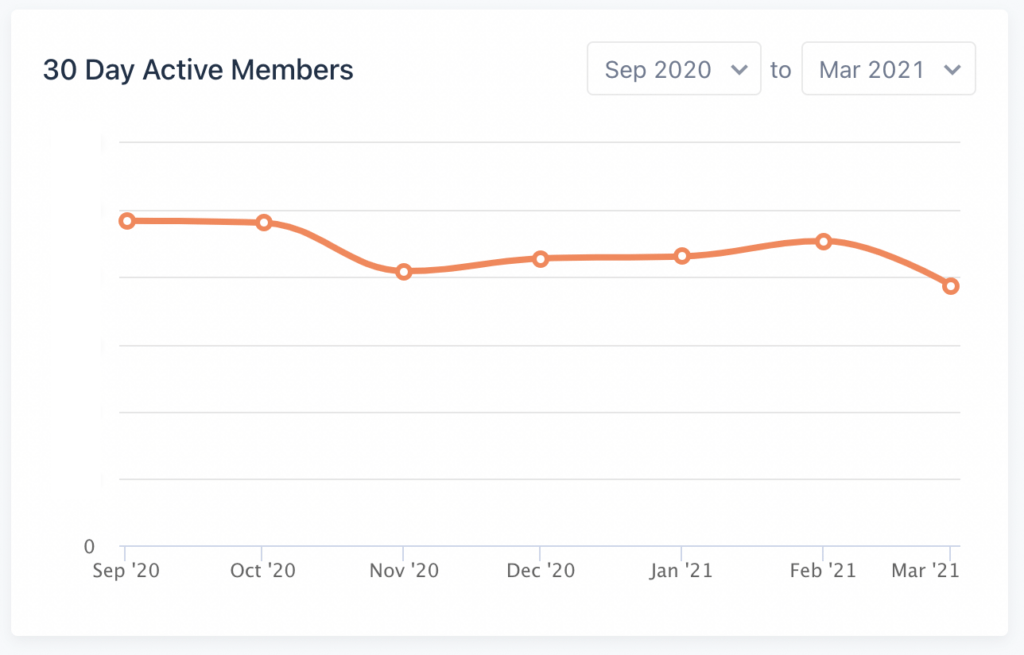Is your membership community doing well? How do you know? The not so simple answer is “metrics.” The not so simple part is because there are an infinite number of data points that you can analyze. Sound overwhelming? Fret not. In my previous post I shared five tips to avoid ruining your membership community, and today I’ll reveal the most important metric every community owner needs to know and measure to ensure the success of their community.
Community professionals understand this world well. A big part of our role is to know which metrics are critical to the health of our communities and which ones are irrelevant. Yelp, for instance, will care a lot about user generated content (UGC) in the form of reviews, while a brand like Peloton will be more focused on membership retention and churn (percentage of cancellations).
Those are obviously big companies with lots of resources. But what about small business owners running their own communities? With so many potential metrics to collect and track, busy business owners may hesitate to start tracking any metrics because it is hard to know which ones really matter.
Getting Started with Metrics: Picking the Right Platform
For those of us who run communities on a smaller scale than Yelp and Peloton, there is still hope. Some platforms will provide metric data for you. And some platforms, generally social media giants, will give you quite limited access. This is one reason why we choose not to invest in social media-based communities.
At Team SPI, we use Circle (affiliate link) for our communities, which provides easy access to several key metrics, making it easy to get a snapshot of engagement and activity. For a business owner with little to no staff, the metrics provided are a great start.

In SPI Pro we pay attention to our active vs. inactive members because we want to make sure everyone is getting the most value from their paid membership. There will always be ups and downs, which is why that dip in November or March isn’t too alarming, but if we start to notice a downward trend that is not recovering month over month, we know we need to spend time talking to our inactive members to see what we can do to re-engage them.
The One Metric to Rule Them All
Active vs. inactive members is one of the key metrics we track to gauge the health of our community. With so many differences between community types and goals, what is the most important metric for every community owner?
Simply put, return on investment (ROI). If you have a strong understanding of what makes your community worth the time and effort, then you can determine its general health.
So what would make your community worth the time and effort?
If you own an online plant shop and launch a community for plant lovers, would you rather see a quieter community but increased sales, or would you be happy with a busy and supportive community with strong brand recognition?
If driving sales is the primary purpose of your community, your ROI will be directly related to your monthly sales numbers and not monthly user engagement. However, if your community purpose is for plant lovers to connect, you should be focused on engagement metrics like daily active users and membership growth.
Finding Your Community’s Purpose
What if you’re having trouble figuring out the purpose of your community?
Here’s a hint: Healthy communities are about connection. People want to connect with each other and join communities about things or beliefs they are interested in. So your community should provide value that fosters connection in a way that makes sense for your brand.
Ask yourself, What is the purpose of my business? Now ask, How can I provide value to the people who use my business?
We already know the purpose of our business at SPI Media is to help people create sustainable income. SPI already provides a ton of educational content, courses, and workshops, and as a result has a large group of customers. So it made a lot of sense to create a community tailored to the customers and followers who have succeeded in launching their own income streams and now want to network with and learn from other entrepreneurs who are trying to take their businesses to the next level.
A Note about the “Investment” Part of ROI
Be clear on the minimum investment required to maintain the community you envision. For example, one of the fastest ways to ruin your community is to neglect engaging with your members through thoughtful content.
And by the way, investing in community means much more than investing money—most notably the investment of time. Whether it’s your own time or that of a community manager, someone’s time is needed to create content, manage the strategy, and do the day-to-day operations. There is plenty that can be automated, but every community still needs regular human attention to thrive.
A Workshop for Membership Community Owners
Do you need help getting clarity on the purpose of your community?
Try our free two-hour mini-workshop, Making of a Membership Community, that goes into detail on how we conceptualized our private SPI Pro community of entrepreneurs. We explore how our first attempt at a community didn’t work (because we needed more clarity on our purpose), how technology is catching up to what we need to run a robust community, our strategy to launch SPI Pro, and the future of memberships.
The truth is, if you know what the purpose of your community is, and the effort you put into the community helps you achieve this purpose, then you have a positive ROI and your community is working.
This doesn’t mean you should ignore all the other metrics. Looking at data trends will help you understand when a slump in activity is a problem or just an expected lull. Spend some time learning about the metrics your community or social platform already provides and start with those.
As someone who has tracked metrics for several different types of communities, I’m here to help. Stay tuned for future posts about how to get started tracking and analyzing common metrics. Until then, assess the ROI of your community and when in doubt, ask your community members what they want to see happening in your community.

 Ray Sylvester
Ray Sylvester Karen Beattie
Karen Beattie

